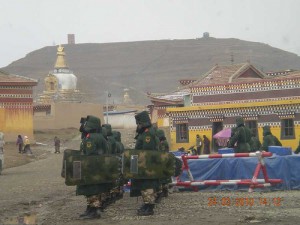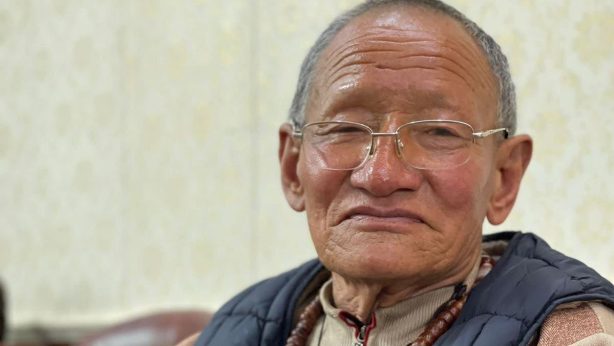Preview of Ancestors’ Tomb: ‘Kirti Monastery has become like a Leprosy Patient’

Mar Jang-nyug (pseudonym) is a Tibetan writer born and brought up in Marong village of Ngaba in the Tibetan province of Amdo. He represents in many ways the number of young University-educated Tibetans, schooled in the Chinese system, a system that Mar Jang-nyug rips apart in a stinging collection of journal entries and personal notes titled “Ancestors’ Tomb”.
TCHRD presents a translated and edited chapter from the book, which will be released in full on 14 August. In this chapter written on 27 May 2012, the author uncovers the oppressive conditions at Kirti Monastery, which continues to remain under lockdown.
Kirti Monastery has become like a Leprosy Patient
Mar Jang-nyug
Since 2008, under the Chinese Communist Party, Kirti Monastery has become a secret cell beyond the comprehension of the people of the Land of Snows.
Kirti Monastery is like a precious jewel in the hearts of the Tibetans from all three provinces of Tibet. It represents a banner of peace that cannot be forgotten by any of us. In the history of the 21st century world, Kirti Monastery of Ngaba, Amdo, has made an indelible mark. People of the world talk about and respect this monastery for raising voices of peace. However, over the years, the monastery has suffered severe repression at the hands of the Chinese Communist Party, who detests peace and freedom. I know that the experience of repression cannot be described in a few words, but I wrote the following note after having a conversation with one of the monks of Kirti Monastery. Readers will get some idea of the kind of repression that the monastery has been subjected to by the Chinese Communist Party:
In 2008, the Chinese police arrested many monks for disrupting the Beijing Olympic Games. Many of the arrested monks suffered physical injuries as a result of police beatings. One person, Sharo Yisha Khalo, even died after he was tortured in prison. When the martyr, Lobsang Tashi, self-immolated, the monk that I talked to was in prison serving a two-year sentence. When the martyr, Phuntsog, burned himself, he was at the Kirti Monastery. The monk said, “There was huge chaos in our monastery, as everyone screamed that a monk had burned himself to death. When we went to see our teachers, they said that the self-immolated monk didn’t belong to our monastery and, therefore, advised us to remain quiet. The teachers were concerned about the affairs of our monastery. But the majority of the monks said the question was not whether the self-immolated monk belonged to our monastery. Expressing their solidarity, they walked out of the monastery to the site of the protest. But the Tibetan masses stopped them. People in the crowd were terrified and trembling, as they said they might suffer a Tiananmen Square-like massacre. A fellow Tibetan then said, “If we can’t even offer our condolences to someone who, without any inhibition, could burn himself to death for our cause, then we are not human beings. I don’t suffer any fear of getting killed today. But today, when I reflect back, fear strikes me, as I believe the students of the Tiananmen protests had never imagined that they would be massacred.”
Later, the family members of martyr Phuntsog suffered many humiliations. The monk said, “Tsering, a friend of the martyr Phuntsog, was sentenced to 13 years in prison. I heard the police tortured him and broke his limbs. Another friend of Phuntsog’s, Nakten, was falsely incriminated and sentenced to prison for 10 years. Later, martyr Phuntsog’s older brother, Kelsang, committed self-immolation. Although he didn’t die, the Chinese took him away. His younger brother, Lobsang Dargay, was sentenced to 2 years in prison.”
He also said:
“Since 16 March 2012, an education committee comprising 600 experts from all over the country visited the Kirti Monastery. The visit was arranged by local officials led by the deputy party secretary and United Front Work Department official Sithar. When the experts were conducting their education, we were allowed to air only one kind of view. That view was whether we wanted the existence of Kirti Monastery or not.
For six months, those 600 experts conducted an intense patriotic re-education campaign featuring 80 points, the key among which was not to fall prey to the manipulation of the splittists of the country and nationalities. Some of the party officials showed us an image of a sack of rice and cooking oil, reminding us not to forget the kindness of the communist party. They accused us of raising slogans of peace from our mouths, but destroying it in actuality. They said we were victims of American manipulation and had forgotten that we were citizens of the People’s Republic of China. They said our extremist and heretical views were harming many people. Their curses made me feel as if Kirti Monastery was responsible for all the crimes of this world.
When you are not allowed to express your own views in an education campaign which is nothing but curses, you feel a strange feeling, of despair, of loneliness. For a long time, outside people were not allowed inside the monastery, and the inside people were not allowed outside. As a result Kirti Monastery became like an abandoned leprosy victim. However, when we later heard that Tsewang Norbu from Kham self-immolated we felt proud. It gave us a ray of light. The Chinese officials lecture a lot about the need to understand the emotions of, and the unity among, the masses; but in reality they don’t understand much about them. They brand all of our activities as splitting the motherland. They planned to imprison more than one thousand monks of the Kirti Monastery, but many folks from the village marched into the monastery and tried to prevent it. As a result, the police arrested many elderly folks with walking sticks and abandoned them in a desolate area. Among these elderly folks, many succumbed to heart attacks.”
With slight sarcastic humour, the monk further said:
“Every time there’s an uprising, the Chinese provide what they call social service to the masses. Each family is provided a sack of rice and told that monks are exploiters and burdens of society. They say that if we participate in protests led by the monks then they would not give us the rice charity. That’s how the Chinese try to drive a wedge between the lay Tibetans and the clergy, but despite all their efforts they haven’t achieved much success. The police took Gyen Tsondru away on the excuse that he needed medical attention, but in actuality he was kept in a detention centre for three months.”
The monk concluded our conversation with these words:
“For years and months, the Chinese divided the monks of the monasteries into five different categories and made attempts to destroy our spirit. But our pride and patriotism remain still unshaken. In fact it was like a lesson to the younger generation—a lesson as to the enormous sacred values of freedom and happiness. However, the Chinese officials lied to the higher authorities, saying ninety-nine percent of monks at Kirti Monastery passed the tests of the patriotic education.”

